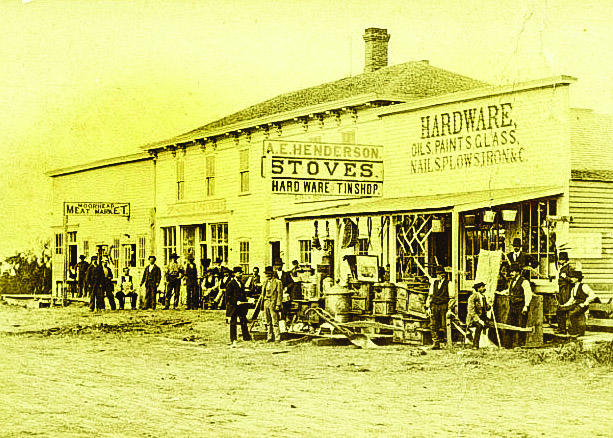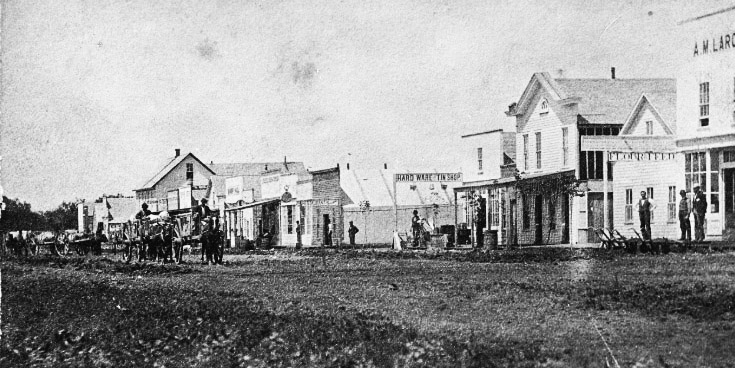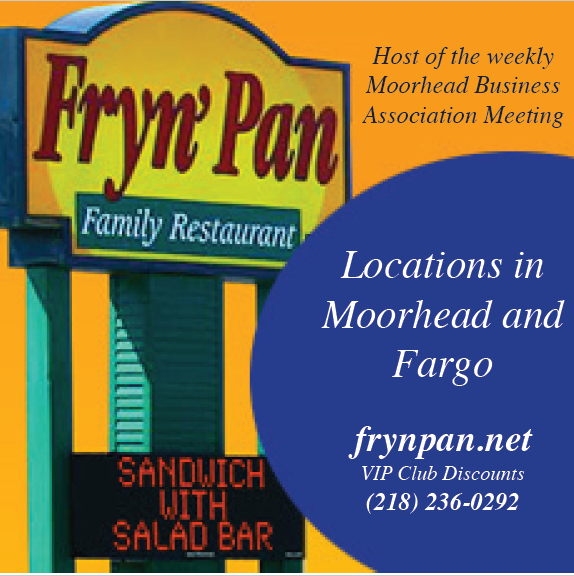
This photo from the 1870s was taken near the site of the infamous shoot-out between Shang Stanton and Slim Jim Shumway on Front Street (Center Avenue) approximately where The Loop, the new library/community center, is being built today.
Nancy Edmonds Hanson
For the third year in a row, Greater Moorhead Days is celebrating the 150th birthday of the city of Moorhead.
Sort of.
Says historian Markus Krueger, “Exactly when the sesquicentennial (150th anniversary) of Moorhead’s founding should be celebrated correctly is a matter of opinion. It does go back that far – but farther.”
In other words, a multi-year birthday party is probably in order. From November 1871, when the Northern Pacific Railway finally announced that it would build its next big river crossing over the Red, to 1875, when Moorhead officially morphed from a township to an actual village, the locale that 45,642 men, women and children now call home was busy evolving from a tent camp of gunfighters, land speculators, miscreants, fortune seekers and railroad workers into a burgeoning frontier village.
“Back in 1875, it was a lot like it is now – a city under construction,” Krueger jokes. As the railway built over the Red to Fargo, then on toward Bismarck, the tent camp evolved into a promising stop on the route that finished America’s transcontinental route. Duluth could be reached by water. Then a group of rich East Coast investors led by Ohio financier Jay Cooke determined to finish the overland route from Duluth to Puget Sound.
Krueger, program director of the Historical and Cultural Society of Clay County, relishes telling Moorhead’s origin story. “The NP left Duluth in 1869 and reached Brainerd in 1870. Hundreds of folks gathered, hoping to land on the spot where the tracks would eventually cross the river, where the next great city of the West would be built.”
He tells of the common belief that the rails would cross on the homestead of Randolph Probstfield. “Four hundred men were living there in tents according to a surveyor, expecting the railway would cross there. Instead, they crossed two homestead to the south in the middle of nowhere, paying Job Smith $2,000 for the land,” he says. “That’s ten times as much as anybody expected.”
And on the day of the announcement, 400 men move three miles south to the present site of Moorhead.
Rough settlements arose on both sides of the river. The historian notes that, while homesteading was legal on the Minnesota side, it was unlawful to the west. Minnesota had become a state in 1858. The land on the Dakota side, however, was still considered native land, off limits to settlers. “They weren’t supposed to live there. It was technically illegal,” Krueger says, “but they moved there anyway.”
Moorhead and Fargo were the true Wild West. “There was no law, no order, no one in charge,” he goes on. “A lot of the very first Moorheadians wanted to live in a town like that. But there were regular people, as well. The question was how they could establish order.”
A famous gun fight on April 25, 1872, provided the opportunity. At the spot where Moorhead’s new library is being built, Shang Stanton and Slim Jim Shumway shot it out in front of a saloon along what was then called Front Street. Shumway was mortally wounded and soon died. Two men died. A mob formed, demanding that murderer Stanton be arrested. That led to the appointment of Jim Blanchard as the first county sheriff, Solomon Comstock as the Red River attorney and David Grant as justice of the peace, along with county commissioners to make the appointments official.
The population ballooned. Residents built the first jail, the first school, and First Presbyterian and St. John’s Episcopal churches. The press started rolling at the Red River Star newspaper. Dr. John Kurtz set his practice. A fire department was formed.
“The first post office started in a tent,” Krueger says. By 1875, postmaster James Douglas had built a permanent structure that doubled as a hardware store near where the FM Hotel would eventually be built.
The population grew from some 400 in 1872 to 3,507 in the official census of 1882. (No census record of Moorhead’s 1875 population survives.) After evolving from township to village in 1875, Moorhead became a city in 1881 complete with a mayor, city government, and Comstock as its first member of the Minnesota Legislature.
With so many milestones to consider, Krueger says the choice of 1875 as the date of its founding was more of a collaboration with Fargo than a true historic marker. The two cities celebrated a shared centennial in 1975 with fanfare, historical writing and a musical play, “Red River Legends.”
Krueger and Tony Tilton, general manager of Moorhead Community Access Media, are nearing completion of a series of videos on Moorhead’s history, starting with “Founding Moorhead.” The collaboration was initiated by the Moorhead Arts and Culture Commission. The production is expected to premier in coming weeks. “We’re already working on the next one, ‘Wild West Moorhead,’” the HCSCC historian reveals, “and there will be more to come.”



